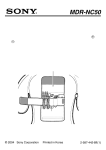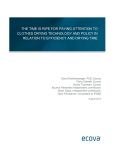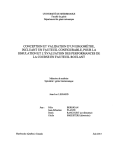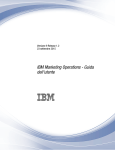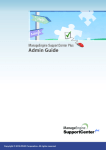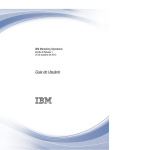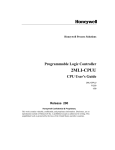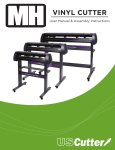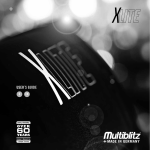Download EPST Soft Torque with Auto Tuning
Transcript
Electroproject Aandrijftechniek Computerweg 21, 1033 RH Amsterdam PO-box 34, 1000 AA Amsterdam The Netherlands Telephone +31 88 484 92 50 E-mail [email protected] Website www.electroproject.nl Businessunit of Cofely Experts bv Electroproject Soft Torque EPST Auto Tune (EPST-AT) Operation manual 2.3 Electroproject Soft Torque Auto Tune Operation Manual EPST-AT version 2.3 / page 1 Operation Manual EPST + Autotune Revision History Rev. 2.2 2.3 Date 02-09-2013 12-09-2013 Description First revision with EPST-autotune revision Applicable from software version EPST-AT Safety Guidelines This manual contains notices you have to observe in order to ensure your personal safety, as well as to prevent damage to property. The notices referring to your personal safety are highlighted in the manual by a safety alert symbol; notices referring only to property damage have no safety alert symbol. Qualified Personnel The device/system may only be set up and used in conjunction with this documentation. Commissioning and operation of a device/system may only be performed by qualified personnel. Within the context of the safety notes in this documentation qualified persons are defined as persons who are authorized to commission, ground and label devices, systems and circuits in accordance with established safety practices and standards. Prescribed Usage Note the following: WARNING The EPST system may only be used for the applications described in this manual and only in connection with devices or components from other manufacturers which have been approved or recommended by Electroproject. Correct, reliable operation of the product requires proper transport, storage, positioning and assembly as well as careful operation and maintenance. When devices or components from other manufacturers, which have been approved or recommended by Electroproject and which are connected with the EPST system, changes due to hardware or software updates possible malfunction of the system arise. IMPORTANT The EPST system will become RIG specific after commissioning. Disclaimer of Liability We have reviewed the contents of this publication to ensure consistency with the hardware and software described. Since variance cannot be precluded entirely, we cannot guarantee full consistency. However, the information in this publication is reviewed regularly and any necessary corrections are included in subsequent editions. Electroproject Soft Torque Auto Tune Operation Manual EPST-AT version 2.3 / page 2 Operation Manual EPST + Autotune Content 1 1.1 1.2 1.3 Preface ...................................................................................................................................... 4 Purpose of this manual .............................................................................................................. 4 Basic Knowledge Requirements ............................................................................................... 4 Position in the information scheme ........................................................................................... 4 2 2.1 2.2 2.3 Stick-Slip mitigation ................................................................................................................ 5 What is “Stick-Slip”? .................................................................................................................. 5 Recognizing when “Stick-Slip” is occurring ............................................................................... 5 How to reduce “Stick-slip”.......................................................................................................... 6 3 3.1 3.2 3.3 3.4 3.5 3.6 3.7 3.8 General ..................................................................................................................................... 7 System overview ....................................................................................................................... 7 EPST control and input.............................................................................................................. 8 Settings ...................................................................................................................................... 9 Speed and torque monitoring .................................................................................................... 9 Advanced data logging ............................................................................................................ 10 Remote access ........................................................................................................................ 10 EPST off-line ........................................................................................................................... 11 Unit system: metric or imperial. ............................................................................................... 11 4 4.1 4.2 4.3 4.3.1 4.3.2 4.3.3 4.3.4 Principle of operation............................................................................................................ 11 EPST HMI Control panel ......................................................................................................... 11 CONTROL: Activate EPST ...................................................................................................... 13 Kf and Cf tuning parameters ................................................................................................... 13 Manual input of Kf and Cf ........................................................................................................ 16 Calculation with BHA and DP entry ......................................................................................... 18 Automatic calculation and activation by EPST Auto Tune algorithm (EPST-AT).................... 23 Initializing EPST-AT................................................................................................................. 24 5 5.1 5.2 5.3 5.4 5.5 5.6 Screens of EPST HMI touch panel ....................................................................................... 25 Home screen ........................................................................................................................... 25 Trend screen ........................................................................................................................... 27 BHA entry screen .................................................................................................................... 28 Auto tune screen ..................................................................................................................... 28 Messages screen .................................................................................................................... 29 User Settings screen ............................................................................................................... 30 6 6.1 6.2 6.3 Maintenance ........................................................................................................................... 31 Trouble shooting guide EPST system ..................................................................................... 31 Procedure: Disabling the EPST system .................................................................................. 32 System Warnings .................................................................................................................... 34 7 7.1 7.2 7.3 7.4 7.5 7.6 7.7 Annex ...................................................................................................................................... 36 Overview installation................................................................................................................ 37 nd EPST connected to the 2 profibus connection of the VFD ................................................... 38 EPST connected in-between the profibus communication cable (bypass) ............................. 39 EPST connected in-between the profibus communication cable (install) ............................... 40 EPST connected to the TD system by controlling the analog I/O signals ............................... 41 Quick Guide manual input Kf and Cf ....................................................................................... 42 Quick Guide using EPST with Auto Tune ENABLED. ............................................................. 43 Electroproject Soft Torque Auto Tune Operation Manual EPST-AT version 2.3 / page 3 Operation Manual EPST + Autotune 1 Preface 1.1 Purpose of this manual This operation manual is part of the Electroproject Soft Torque (EPST) documentation. The manual provides information and guidelines for the operation of the EPST system. The manual is intended for drillers and engineers operating the EPST system. This manual has been derivated from the standard EPST operation manual and supplemented with operation instructions for the use of EPST Auto Tune (EPST-AT) functionality. 1.2 Basic Knowledge Requirements General knowledge in the field of drilling installations, electrical installations and automation engineering is required to understand this manual. Off-shore installations Additional knowledge in the field of off-shore electrical installations and requirements are needed. Explosion Proof- installations Additional knowledge in the field of off-shore installations and requirements are needed. 1.3 Position in the information scheme This manual is part of the Electroproject Soft Torque (EPST) documentation. The information below presents an overview of the information landscape of EPST system. Technical request form. Provides needed technical data from top-drive system to start engineering of EPST system. Installation and mounting instructions. Provides guidelines for the installation and erection of EPST system. Installation Rig System On Paper (IRSOP) procedure. Provides guidelines for the commissioning and start up of EPST system. Operation manual. Quick reference guide to EPST touch screen We trust that following these instructions, the EPST system will positively contribute to your operating results for many years to come. We will be pleased to supply you with further information and assistance as regards installation of your EPST system. The Electroproject address is: Electroproject Computerweg PO-box Telephone E-mail Website Electroproject Soft Torque Auto Tune Aandrijftechniek 21, 1033 RH Amsterdam (The Netherlands) 34, 1000 AA Amsterdam (The Netherlands) +31 88 484 92 50 [email protected] www.electroproject.nl Operation Manual EPST-AT version 2.3 / page 4 Operation Manual EPST + Autotune 2 Stick-Slip mitigation What is “Stick-Slip”? 2.1 “Stick-slip” is a common occurrence in drilling operations that can result in harmful rotational vibrations in the drill-string. Although the drill-string is continuously rotating at surface during the drilling operation, friction on the bit, bottom hole assembly (BHA) and/or drill-string itself can cause it to “stick” down hole. As rotation at surface continues and torque in the drill-string builds up, this ‘stick’ friction is suddenly overcome causing a sudden increase in speed ("slip") as the drill-string 'unwinds' itself. When fully developed, stick-slip can cause the bit and BHA rotation to completely stop and accelerate up to 5-6 times the surface r.p.m. “Stick-slip” can cause: - damage to the bit; broken cutters; decreased rate of penetration (ROP) decreased bit life. Furthermore, it can also damage other down hole components such as rotary steerable systems, and Measurement While Drilling devices (MWD). It can even cause down-hole motors to stall. 2.2 Recognizing when “Stick-Slip” is occurring There are two clear stick-slip indicators for the driller: 1. Large variations in surface torque. 2. Large variations in downhole RPM. The torque variations can be accompanied by “groaning” noise coming from the top drive. Characteristic for the slip-stick behaviour is the sawtooth behaviour of the torque, which can go up to 50% torque variation. In Figure 1 is an example of the characteristic sawtooth torque variations. This behaviour can only be seen clearly when using data with at least 1-second sample time. Figure 1: Torque variations due to stick-slip Electroproject Soft Torque Auto Tune Operation Manual EPST-AT version 2.3 / page 5 Operation Manual EPST + Autotune 2.3 How to reduce “Stick-slip” Stick-Slip only occurs at a rotary speed below a certain threshold value. The threshold value depends on system parameters such as design of the drill-string, mud, bit, BHA and weight on bit (WOB). The driller can reduce stick-slip by: 1. Increasing the rotary speed (RPM); 2. Reducing the weight on bit (WOB); 3. Add lubricants to the mud system; 4. Install Electroproject soft torque system (EPST) to reduce Stick slip. Please note that EPST, is the first soft torque system specifically developed for AC top drives and modern DC drives. Soft Torque technology has been in use since the early ‘90’s. Figure 2: Activating soft torque In Figure 2 at 1332 seconds soft torque is switched on. Torque becomes smoother and speed variations are greater. This is typical when soft torque is active. Electroproject Soft Torque Auto Tune Operation Manual EPST-AT version 2.3 / page 6 Operation Manual EPST + Autotune 3 General 3.1 System overview The EPST system is designed to be easily implemented in modern drive systems. The EPST controller is a standalone but RIG specific µ-processor based controller. It can operate without any interface with the RIG-controls. To implement the system the following hardware is required (see figure 3): 1. Touch panel to operate the system (HMI). 2. Industrial PC (IPC). The Soft Torque controller. 3. Additional PROFIBUS communication interface with variable frequency drive (VFD) 4. Ethernet communication between touch panel and IPC 5. If not already present, speed encoder at TOP DRIVE motor. ST control panel (HMI) 1 Profibus 2 PLC Controller 4 ST Controller (IPC) Profibus 1 VFD 2 Actual speed 3 (digital encoder feedback) Motor Gearbox Drill string And bottom hole assembly 5 Figure 3: EPST System overview (extra profibus example) To make the controller work properly a fast connection between VFD and EPST controller is necessarily. In the block diagram above this fast connection has been made with a second profibus interface to the VFD. Electroproject Soft Torque Auto Tune Operation Manual EPST-AT version 2.3 / page 7 Operation Manual EPST + Autotune Another most common implementation example: ST control panel EPST Controller (IPC) Ethercad Ethernet VFD PLC Controller Actual speed (digital encoder feedback) Moto r Gearbox Drill string And bottom hole assembly Figure 4b: EPST System overview (in-between original profibus example) 3.2 EPST control and input With the touch panel the EPST controller can be operated and speed and torque variables can be monitored. The EPST controls consist of: 1. 2. 3. 4. Switching Soft Torque (ST) ON and OFF. Switching Soft Torque Auto Tune (AT) ON and OFF. Entering the right settings for the tuning parameters Kf and Cf. Alternatively calculation of Kf and Cf depending on BHA and Drill pipe specifications Electroproject Soft Torque Auto Tune Operation Manual EPST-AT version 2.3 / page 8 Operation Manual EPST + Autotune 3.3 Settings The user settings can be found at the “Settings” screen on the EPST-HMI control panel. System settings can be accessed at directly at the EPST-IPC and only need to be modified by the EPST specialist while commissioning. IMPORTANT The EPST system can only be used after been commissioned by an Electroproject EPST specialist. 3.4 Speed and torque monitoring On the touch panel, actual values of speed and torque can be monitored in real-time. These values can also be monitored graphically in a trend display of 120 seconds. An adjustable filter time for all display values can be set in the settings screen to avoid aliasing of the sampled trend due to the communication speed between the touch panel and the EPST controller. Electroproject Soft Torque Auto Tune Operation Manual EPST-AT version 2.3 / page 9 Operation Manual EPST + Autotune 3.5 Advanced data logging The EPST controller is programmed in an IPC (Industrial PC). The operating system is Linux. The IPC also functions as a data server for logging purposes, the EPST-server. The EPST-server, stores the actual values of all inputs, outputs, variables, markers and parameters to hard disk. When the VFD is operating, the resolution of this log data is 5ms (200Hz sampling). Depending on the size of the applied hard disk(s), log data can be hold for months. Figure 5: Screenshot ST log-data view program The log data can be viewed, exported and analysed with a special EPST data-log view program. The EPST data-log viewer can be installed on a Windows based PC. 3.6 Remote access If the IPC is connected to a WAN network, log data and status of the IPC can be remotely accessed. Even remote assistance and updates are possible. If a connection has to be made between the EPST network (IPC and touch panel) and another network, a specific TCP/IP setting has to be made. These settings can only be changed by Electroproject personal. The standard IPC TCP/IP configuration is stand-alone but RIG specific with a DHCP server enabled. Please contact us for other configurations. Electroproject Soft Torque Auto Tune Operation Manual EPST-AT version 2.3 / page 10 Operation Manual EPST + Autotune 3.7 EPST off-line Since the EPST system is designed as a standalone but RIG specific controller the drill operation can continue if the EPST system is off-line. Drill operation can continue with disconnected EPST system. If the EPST is turned off, the original control of the VFD is restored. 3.8 Unit system: metric or imperial. The unit system can be changed in the “settings screen” IMPORTANT A common cause of problems with operation is wrong data input. Wrong data input can be caused by the wrong choice of unit system. 4 Principle of operation An oil-rig's top-drive is a multi-purpose controllable high power drive. During drilling the drill-pipe is the intermediate between a drill and the top-drive. A practical problem is so called `stick-slip' while drilling. Experience shows that a relatively constant speed of the bit is optimal for effective penetration, low drill wear and good steering conditions. At certain depths and depending on drilling conditions, among others: friction on bit, drill speed and weight on bit, the drill bit can “stick” down hole while the drill string keeps rotating. The drill-pipe acts as a torsional spring. Since the Top Drive does not recognize the “stick” of the drill bit, the rotation of the drill pipe continuous and the drill-pipe will wind up. As a result the torque in the pipe builds up. At a certain torque value the “stick” friction is overcome and the drill-bit suddenly increase in speed while the drill pipe “unwinds” itself. The large speed variations can damage downhole components, including the bit itself. Furthermore, stick-slip is known to decrease ROP by some 25%. Also steering rotary drilling operation is very difficult under “stick-slip” conditions. The EPST system is designed to mitigate the stick-slip behaviour. 4.1 EPST HMI Control panel Controlling the EPST soft torque system is done on a HMI touch screen. Buttons Buttons are operated by touching the displayed symbol on the screen WARNING Accidentally touching the screen could activate unwanted functions. To wipe the screen clean see chapter 0 (Clean screen function) Electroproject Soft Torque Auto Tune Operation Manual EPST-AT version 2.3 / page 11 Operation Manual EPST + Autotune Numeric input Figure 6: Numeric key-pad 0–9 ‘ ← = numeric input values = = = Backspace ESC Del Ins Num = Enter = Escape = Delete = Insert = move cursor to left = move cursor to right = Toggle Numeric / Alphabetic keypad The alphabetic keypad will not be described because no alphabetic input is required. Bottom section of the screen Depending on the version of the EPST control software and the available options, the below “screen selection buttons” will be present at the bottom section of each screen (see figure 6). Figure 7: Bottom section of the screen By selecting one of the screen selection buttons the selected screen will be activated. The screens will be described in the next chapters. Upper section of the screen Alarm sign/button Actual mimic (screen) IPC time Info Screen button Figure 8: Upper section of the screen Alarm signal and button: If a warning is active the button “Warning if flashing” will be flashing. By pressing the button, the warning screen will be opened. Active warnings will be displayed. See paragraph 6.3 Actual mimic: In the middle at the upper section of the template the name of the actual screen (mimic) is shown. Electroproject Soft Torque Auto Tune Operation Manual EPST-AT version 2.3 / page 12 Operation Manual EPST + Autotune IPC time: The actual time of the EPST industrial pc (IPC) is shown. This is not the actual time of the HMI clock. This time is used with the log data and messages of the EPST IPC. Info screen button: By pressing on the “Electroproject Aandrijftechniek” logo the info screen of the EPST system is shown. The info screen gives the Electroproject contact data and some background information of the EPST system. 4.2 CONTROL: Activate EPST Switching EPST ON and OFF is done by the “Activate EPST” button (toggle function) on the “Home screen”. The button is grey when EPST is not active and green when active. Figure 9: Activate EPST button "OFF state" If pressed “Activate EPST” EPST will be switched ON and automatically the “Next Kf / Cf” values will become active. Figure 10: Activate EPST button "ON state" If pressed “Activate EPST” EPST will be switched OFF. Switching ON the EPST controller can be done “bump less” while the top drive is running. If the EPST controller is switched OFF the original speed controller of the variable frequency drive (VFD) become active again. IMPORTANT Make sure that the right “Next values of Kf and Cf” have been set. This can be done manually, by calculation with BHA and drill pip entries or automatically by EPST AutoTuning (EPST-AT). EPST will be switched OFF automatically or cannot be switched on when: 4.3 a communication error occurs between IPC and VFD; communication timeout between touch panel and IPC has been exceeded; See chapter 5.7 “EPST-time-out display” the VFD speed setpoint is less than the “Auto switch off speed”. See chapter 5.7 “Auto switch off”. the VFD is switched off. The Kf / Cf settings are out of range Kf and Cf tuning parameters The EPST controller is a speed controller tuned with the Kf (drive stiffness in Nm/rad) and Cf (drive damping in Nms/rad) values. Depending on the drill string and BHA configuration the tuning parameters Kf and Cf are calculated. Electroproject Soft Torque Auto Tune Operation Manual EPST-AT version 2.3 / page 13 Operation Manual EPST + Autotune EPST will be able to improve damping of stick-slip when the two tuning parameters Kf and Cf are on target or not too far from ideal values. Also drill speed needs to be above a threshold value. Compared to normal operation (EPST is not activated) the threshold speed value above which stick-slip cannot exist, is lower when soft torque is on. IMPORTANT When “Auto Tune with auto transfer” is not used, Kf and Cf must be adjusted each time the drill string configuration changes (e.g. adding a stand)! The EPST system has “Actual” and “Next” Kf Cf settings for the EPST controller: Figure 11: Kf / Cf values on the “Home Screen” Electroproject Soft Torque Auto Tune Operation Manual EPST-AT version 2.3 / page 14 Operation Manual EPST + Autotune The Kf and Cf values with the black background are the actual “used” values when EPST is active. These values cannot be changed directly. Each time EPST is activated by pressing on the “Activate EPST” button, the Next values will be copied to the actual values directly except when the next values differs to much with the actual ones. There are four ways to specify the next Kf and Cf settings. 1. 2. 3. 4. Manually input of Kf and Cf (Home screen) Calculation with integrated BHA and drill string configuration. (BHA and Drill pipe entry screen) Automatic calculation and activation by EPST Auto Tune algorithm (EPST-AT) By the “Initialize AT” function on the “Home Sreen” If correct settings are available in the next Kf and Cf values EPST can be activated with the “activate EPST” button. When the next values differ more than the in the settings set percentage “Max. difference next and actual Kf/Cf” the next values will be coloured dark orange. Then, if the “Activate EPST” button is pressed a pop-up window will show: Figure 12: Pop-up when activating EPST Electroproject Soft Torque Auto Tune Operation Manual EPST-AT version 2.3 / page 15 Operation Manual EPST + Autotune Possible reasons for a certain difference between the “old” and “new” values: - EPST-AT has been switched off for a couple of stands. In the meantime the calculated Auto Tuning values are changed more than the last actual ones. EPST-AT has not been able to produce next Kf and Cf values for a while. After (re-) initializing the “Next Kf / Cf” values with the “Initialize-AT” button it is most likely that these next values are different than the actual ones. Wrong manual input or first time manual input Skipped manual input of new Kf/Cf values for a while Restart using EPST like starting a new hole. IMPORTANT The EPST controller continuously checks if the actual values of Kf and Cf are out of range. The settings are out of range if one of the following conditions is true: Cf < 300 or Kf < 300 Cf > 15000 Kf > 10 * Jtd Where Jtd is the inertia of the top drive. Note. Chapters 4.3.1 untill 4.3.2.3 are mentioned for Manually Input of Kf and Cf 4.3.1 Manual input of Kf and Cf Manual input of Kf and Cf is always possible. Entering the right settings must be done on the “Home” screen by touching “Next Kf and Cf” input fields. If working with manual input of Kf and Cf a table must be provided with Kf and Cf values for each bit depth. This sheet is normally provided by SHELL. To make the EPST controller work properly the right Kf and Cf parameters must be entered depending on bottom hole and drill string assembly configuration. This can be done by touching the input fields of the “Next Kf and Cf values” on the main screen and must be repeated after every stand. For input of Kf and Cf a data sheet must be available with the pre-calculated Kf and Cf values. Normally this sheet is provided by SHELL. IMPORTANT Soft Torque may be in the on state while changing the Next Kf and Cf values. Make sure when activating EPST by “Activate EPST” proper next Kf / Cf values are filled in. When manual input of the next Kf/Cf values is desired switch off “Auto Tune” and / or switch of the “AT-Auto transfer function” on the settings screen. Else the manual filled in values will be overwritten by the auto-tune function! Kf and Cf values must be adjusted during drilling according to the drill depth to make the EPST controller work properly. Wrong settings can cause instability of the system. Ask for new data sheet if drill string or BHA configuration is changed. Electroproject Soft Torque Auto Tune Operation Manual EPST-AT version 2.3 / page 16 Operation Manual EPST + Autotune Example part of Kf and Cf sheet as provided by Shell: Total Measured Depth (along hole) Tuned values Total MD m Kf Nm/rad Cf Nms/rad 1800 1829 1857 1886 1914 1943 1971 2000 2028 2057 2085 2114 6188 6046 5909 5776 5649 5525 5406 5290 5178 5070 4965 4863 2523 2508 2493 2478 2464 2449 2435 2422 2408 2395 2382 2369 This table is unique for each top-drive, drill string and BHA configuration. Procedure manual input Kf and Cf 1. Check if correct Kf and Cf table is available for the current configuration. 2. Select Home screen. 3. Select “Next Kf” input field (press at the Next Kf numeric field). 4. Numeric keypad will appear. 5. Depending on total measured depth (MD) fill in the right Kf value (see example). 6. Before pressing enter button check if the entered value at the Kf field is correct. 7. Confirm value by pressing enter button. 8. Enter the new “Next Cf” value, same procedure as “Next Kf” (step 3 to 8). 9. EPST controller is now ready to be (re-) activated. Note: If the EPST controller was still activated while changing the next Kf/Cf values, EPST must be first deactivated and activated again to make the new Kf/Cf values active! Example for selecting Kf and Cf values A new stand is inserted. Current total MD = 1975 meter. The next total MD in the provided table is 2000 meter. The corresponding values of Kf and Cf in the provided table are Kf = 5290 and Cf = 2422. Enter these values in the corresponding input fields at the “Home” screen. Before activating EPST again, check if values on the touch panel are correctly entered. Electroproject Soft Torque Auto Tune Operation Manual EPST-AT version 2.3 / page 17 Operation Manual EPST + Autotune 4.3.2 Calculation with BHA and DP entry Alternatively, the EPST controller can calculate the values of Kf and Cf. For this calculation the configuring of the bottom hole assembly (BHA) and the drill string data has to be inputted in the EPST. The input of data and calculation is done on the “BHA-entry” and “Drill Pipeentry” screen (for a detailed description see chapter 4.3.2.1 and 0). The drill pipe entry screen does have a total of three different drill pipe parts to configure. Item one is the lowest (connected to the BHA) and must be first selected. A pipe part can be added by selecting a pipe name from the database and enter the TOTAL length of the stands. Just adjust the length of the highest pipe part item (connected to the top drive) each time a connection has been made and then recalculate the Kf and Cf. 4.3.2.1 BHA (Bottom Hole Assembly) Entry screen Alternative to the manual input of KF and Cf, the EPST controller can also calculate the values of Kf and Cf. For this calculation the configuring of the bottom hole assembly (BHA) and the drill string data has to be inputted to the system. The input of data and the calculation of the tuning parameters is done on the “BHA-entry” and “Drill Pipe-entry” screen (see chapter 4.3.2.2). Figure 13: BHA Entry screen The BHA entry screen has a maximum of 5 items to enter. Obviously, in practice, a BHA will have more components. The most significant components in the BHA, in terms of weight and length, MUST be entered; such as HWDP and / or DC. The length of smaller components, like the bit, motor, stabilizers, MWD and jars have to added to the main components in the BHA when using the BHA entry screen. For the first four items four parameters should be entered: Electroproject Soft Torque Auto Tune Operation Manual EPST-AT version 2.3 / page 18 Operation Manual EPST + Autotune 1. 2. 3. 4. Material. Outer diameter. Inner diameter. Length. “No Item”, “Normal” or “Non-magnetic” The outer, inner-diameter and length can be entered by selecting it’s numeric input field. Because of the huge variety of BHA components there is only a standard drill pipe database implemented in the EPST system. HWDP or normal DP’s can be selected in item 5. The rest of the BHA components must be configured at items 1 till 4. By lumping the BHA into four major items the BHA entry can be simple and it is not necessary to maintain a large data base. The BHA items must be entered from the bit up! Item one is closest to the bit! Unused items will not be included in the calculations. It is recommended to always use the four available items to input the BHA, to make the tuning as accurate as possible. Material: The settings for material are: 1. Normal. 2. Non-magnetic. 3. No-Item. If “No item” is selected as material this item will not be part of the calculation of Kf and Cf. Outer diameter, inner diameter, Length: Fill in the sizes of the configured BHA items. Note: The unit system can be changed in the “settings screen”. The fifth item is meant for selecting a standard heavy drill pipe from the predefined database. Select the use heavy drill-pipe used in the BHA. Add all used lengths of the BHA HWDP’s and fill it in the length field of item five. BHA Calculations: The calculation of Kf and Cf can only be started after the drill pipe has been configured at the “Drill Pipe Entry” screen. IMPORTANT Once drilling has started with a certain BHA configuration, the entries on this BHA entry screen don’t have to be adjusted anymore. Note: The units of diameter and length can individually changed on the settings screen (m / inch): Electroproject Soft Torque Auto Tune Operation Manual EPST-AT version 2.3 / page 19 Operation Manual EPST + Autotune 4.3.2.2 Drill Pipe Entry screen Figure 14: Drill Pipe Entry screen The drill pipe entry screen does have a total of five different drill pipe sections to configure. Item 1 is the lowest (connected to the BHA) and must be entered first. In case this drill pipe section runs all the way to surface, items 2, 3, 4 and 5 will remain unused. Pipe name and ID field: There are different pipe choices available. Select one of the pipes from the pull-down menu at each pipe name field, corresponding or closest to your DP specification. Pipe database will continuously be updated according to the Shell Kf & Cf Spreadsheet. It still could be that not all pipes are known in the database. Updating the database can only be done by an EPST engineer. The moments to update the database are before or during the Installation & Commissioning and during maintenance. Electroproject Soft Torque Auto Tune Operation Manual EPST-AT version 2.3 / page 20 Operation Manual EPST + Autotune Available pipes in HMI version 1.18 (7.7 Shell drill pipe database) are: Pipe index Pipe name 1 3 1/2" DP - 9.50 lb/ft - NC38 2 3 1/2" DP - 13.30 lb/ft - NC38 3 4 5 6 7 8 9 10 11 12 13 14 15 16 17 18 19 20 21 22 23 24 25 26 27 28 29 30 31 32 33 34 3 1/2" DP - 15.50 lb/ft - NC38 4" DP - 11.85 lb/ft - NC46 4" DP -14.00 lb/ft - CYX105-120 4" DP -14.00 lb/ft - XD105 4" DP -14.00 lb/ft - G-109 4" DP - 14.00 lb/ft - NC40 (FH) 4" DP - 14.00 lb/ft - GT-type1 4" DP - 15.70 lb/ft - HT38 4" DP 15.7 lbft - NC40 4 1/2" DP - 13.75 lb/ft - NC50 4 1/2" DP - 16.6 lb/ft - NC50 4 1/2" DP - 20.00 lb/ft - NC50 5" DP - 19.50 lb/ft - NC50 5" DP -19.50 lb/ft - G-105 5" DP - 25.60 lb/ft - NC50 5 1/2" DP - 21.90 lb/ft - FH 5 1/2" DP - 21.90 lb/ft - HT55 5 1/2" DP - 21.90 lb/ft - FH (CB) 5 1/2" DP - 21.90 lb/ft - FH CDS 5 1/2" DP - 24.70 lb/ft CYX105-120 5 1/2" DP - 24.70 lb/ft XD 105 5 1/2" DP - 24.70 lb/ft - S-135 5 1/2" DP -XT54 26.73 p/f (24.7p/f IEU) 5 7/8" DP - 23.4lb/ft S-125 VAM VX57 5 7/8" DP - 23lb/ft - GT-Type2 5 7/8" DP - 26lb/ft - GT-Type3 5 7/8" DP - 46.18lb/ft S-135 XT57 6 5/8" DP - 25.20 lb/ft - FH 6 5/8" DP - 27.70 lb/ft - FH 6 5/8" DP - 27 lb/ft - GT-Type4 6 5/8" DP - 34 lb/ft - GT-Type5 6 5/8" DP - 40 lb/ft - GT-Type6 Electroproject Soft Torque Auto Tune Pipe index Pipe name 35 2 7/8" HWDP - NC26 (2 3/8" IF) 3 1/2" - 2 1/16" HWDP - NC38 (3 36 1/2" IF) 3 1/2" - 2 1/4" HWDP - NC38 (3 1/2" 37 IF) 38 3 1/2" - 2 1/4" HWDP - HT38 39 3 1/2" - 2 1/4" HWDP - XT39 40 4" HWDP - NC40 - NC40 (4 FH) 41 4" HWDP - XT39 42 4" HWDP - NC40 - XT39 43 4" HWDP - HT38 44 4 1/2" HWDP - NC46 (4 IF) 45 5" HWDP - NC50 (4 1/2" IF) 46 5" HWDP - HT50 47 5 1/2" HWDP - 5 1/2" FH 48 5 1/2" HWDP - 5 1/2" FH (CB) 49 5 1/2" HWDP - 5 1/2" FH VAM CDS 50 5 1/2" HWDP - XT54 51 5 1/2" HWDP - HT55 52 5 7/8" HWDP - XT57 53 5 7/8" x 4 1/4" HWDP -VAM VX57 54 6 5/8" HWDP - 6 5/8" REG Interdrill 55 6 5/8" HWDP - 6 5/8" FH Operation Manual EPST-AT version 2.3 / page 21 Operation Manual EPST + Autotune Total length: When switching ON the EPST system for the first time during a drilling process the existing pipe configuration needs to be inputted. Start to fill in the lowest (connected to the BHA) pipe part and fill in the total length of the corresponding pipe by using the numerical keypad. Drill pipe entry length: Each time a connection has been made the length of the concerning drill pipe entry must be adjusted. This can be done by touching the "Length" field of the current drill pipe entry and fill in the right length or by means of the "+" button. If the "+" or "-" buttons are used to adjust the drill pipe entry length, the right actual "One pipe stand" length must be set up correctly. This can be done by touching the "one stand" field in the current drill pipe entry row. If applicable a new drill pipe entry must be added by selecting a pipe name at the next not used drill pipe entry row. The "+" and "-" buttons is a tool to adjust easily a drill pipe entry length each time a stand is added. The mean length of the used stands must therefore be filled in the "One stand" length field. Calculate: If the settings of the BHA have been altered at the BHA entry or the settings of the drill pipe have been changed the “calculate” button starts blinking. This indicates that a calculation of the Kf and Cf values has to be made. Just press the “calculate” button to recalculate the Kf and Cf values. Transfer: If the calculated values differ from the current values of Kf and Cf, the “transfer” button starts blinking. Press the transfer button to copy the calculated values to the current (active) values of Kf and Cf. IMPORTANT Soft Torque must be in the off state before changing the Kf and Cf parameters. Wrong settings can cause instability of the system. The current values of Kf and Cf on this screen are the same values showed on the home screen. 4.3.2.3 Procedure for Kf and Cf calculations with BHA an Drill pipe calculation See also paragraph 4.3.2.1 and 4.3.2.2. New configuration: 1. Select Home screen 2. Switch EPST OFF 3. Select BHA Entry screen 4. Fill in BHA settings at the BHA entry. See paragraph 4.3.2.1 5. Select Drill Pipe Entry screen 6. Fill in (existing) Drill pipe settings at the Drill Pipe entry. See paragraph 4.3.2.2 7. Press calculate button 8. Press orange transfer button 9. Select Home screen 10. Activate EPST Electroproject Soft Torque Auto Tune Operation Manual EPST-AT version 2.3 / page 22 Operation Manual EPST + Autotune Connecting new stand: 1. Select Home screen 2. Switch EPST OFF 3. Select Drill Pipe Entry screen 4. If applicable a new drill pipe entry must be added by selecting a pipe name at the next not used drill pipe entry row 5. If necessary adjust length of one stand by using numerical keypad 6. Press “+” button or adjust the length field to add a stand length to the drill pipe entry with the highest number. 7. Press “Calculate” button to calculate new Cf, Kf and length values. 8. Press “Transfer” button to make new calculated values active. 9. Select Home screen 10. Switch EPST ON 4.3.3 Automatic calculation and activation by EPST Auto Tune algorithm (EPST-AT) EPST-AT is a new developed Soft Torque Auto Tune algorithm patented by Electroproject. EPST-AT differs from other auto tune algorithms because it really identifies the drill string and BHA while the drill string is rotating. Although soft torque is mainly used to mitigate “stick slip” it is proven that soft torque has a positive effect on the drill process even if there is no stick slip! EPST-AT can be used when there is no stick slip in contrast to other soft torque auto tune algorithms. EPST-AT analyses high resolution measured top drive data (torque / speed) while operating the top drive. It provides automatically the tuning parameters (Kf / Cf) for the EPST Soft Torque controller. With EPST-AT there is no need to manually enter these parameters or configure the drill string and bottom hole assembly at the EPST control panel! The EPST-AT function can be enabled or disabled. If it’s enabled, it will analyse data while the top drive operates and EPST Soft Torque is activated. The EPST-AT algorithm analyses measured drill data in blocks of ten minutes. If the first block contains “usable” information in the data it can calculate directly the tuned values of Kf and Cf. If there is not enough information in the data, it takes another block or more to identify the Kf and Cf values. When EPST is switched off and on again (add stand) the actual Kf an Cf values of the EPST controller will be updated with the calculated values from the EPST-AT algorithm. Note: Keep in mind that if stick slip is present, the EPST-AT algorithm is not capable to produce Kf and Cf auto tune values at a regular basis! If no new Kf and Cf are estimated the drilling conditions must be changed (rpm, WOB) so new values can be estimated. 4.3.3.1 CONTROL: “Auto tune” and “Initialize” button The “Auto tune” button enables the EPST auto-tune-algorithm when EPST is enabled (switched on). When Auto Tune is enabled next Kf/Cf values will be estimated automatically when drilling and EPST is enabled. When EPST is re-enabled the new “Next values” will become active. Electroproject Soft Torque Auto Tune Operation Manual EPST-AT version 2.3 / page 23 Operation Manual EPST + Autotune If EPST is activated with EPST-AT enabled, it takes a while before the system can estimate the first calculated next Cf/Kf values! The AT algorithm is only active while EPST is enabled. When starting to use AT the Kf/Cf values must first be initialized (see paragraph 4.3.4) . Press the “Initialize” button when start using EPST-AT before activating EPST. 4.3.3.2 Procedure for using EPST with auto tune function enabled 7 Check on the settings screen if “Auto Tune” and “AT-Auto Transfer” are enabled EPST-AT must be “initialized” with the “Initialize-AT” button on the home screen when starting a new hole or start using it after a different depth the last time it was used! Start using EPST by activating it with the “Activate EPST” button on the home screen. After a short time the “AT-Active” indicator will appear meaning that the EPST-AT algorithm is working in the background. After minimal 10 minutes drilling with EPST-AT the first estimated values will appear in the “Next Kf/Cf” fields on the home and auto tune screen. If this happens, also the green “AT-NV” will be appear on the home screen. Disable or let EPST switch off automatically when adding a new stand. After adding a stand, start normal drilling again and activate EPST again. When the next values of Kf and Cf were in range of the actual ones (set on the settings screen with the “Max. difference next and actual Kf/Cf” setting), the next values estimated while drilling the previous stand will be used automatically as actual values. Go to step 4. 4.3.4 Initializing EPST-AT 1 2 3 4 5 6 Use the “Initialize AT” button to calculate new start values for the EPST-AT. Because EPST-AT can only produce EPST tuning values when EPST is activated, Kf an CF “start values” must be calculated to begin EPST with. If no other start values for EPST are present, use this button. When pressing on the “Initialize AT” button a pop-up screen will appear: Pop-up window to Initialize EPST settings. Fill in the approximately actual depth of the drill bit and press enter. After pressing “Accept measured depth” start values will be calculated and used as “Next Kf and Cf values. When EPST is activated these values will be used as “actual Kf and Cf values”. Electroproject Soft Torque Auto Tune Operation Manual EPST-AT version 2.3 / page 24 Operation Manual EPST + Autotune The shorter the measured depth, the higher the next Kf and Cf values will be. If the entered depth is too low, the calculated next values of Kf and Cf will be out of range. A fault will be generated: “Kf/Cf settings out of range” after trying to activate EPST. Because the maximum Kf value is top drive independent a minimum depth for the initialization button cannot be given (Kf max is ten times the inertia of the top drive). 300 < Cf < 15000 and 300 Kf < 10 * Jtd. Try to increase the initialization depth till the above criteria meets. 5 Screens of EPST HMI touch panel In this chapter all EPST HMI screens will be described. 5.1 Home screen This is the “start-up” screen of the EPST HMI control panel. On this screen an overview of the system is shown. Gauges and trends with actual drill speed and pipe torque are shown. Changing the display values from metric to imperial can be done at the “settings screen”. Figure 15: Home screen Electroproject Soft Torque Auto Tune Operation Manual EPST-AT version 2.3 / page 25 Operation Manual EPST + Autotune Speed gauge The speed gauge gives the value for the actual drill speed of the TOP DRIVE (TD) in rpm. Torque gauge The torque gauge gives the value for the actual pipe torque applied at drill pipe. Tmax displays the actual Torque Limit. SSI “Stick slip indicator” The value displayed by the stick slip indicator is the measured peak-peak torque ripple on the pipe torque. The red graphical bar has a 0-40 kNm scale. The lower the showed values the better. “AT-active” and “AT-NV” indicators The green “AT-active” indicator will show up when AT and EPST is activated and the AT algorithm is estimating Kf an Cf values. The green “AT-NV” (Auto Tune New Value) indicator will show up when the EPST-AT algorithm has found a the first new value after activating EPST. “Auto Tune” button The Auto Tune button enables the EPST auto tune algorithm. When EPST is activated, Kf and Cf values will automatically estimated for the current drill string. “Initialize button” Next Kf an Cf values will be calculated by input of measured depth. Use only when starting EPST with auto tune enabled for de first time of a new hole! Trend display The trend display shows the time related graph of drill speed and torque. For a better indication of speed and torque choose the TREND display. See chapter 5.2 The time scale (x-axis) is fixed. The graph shows the last 120 seconds. The trend display does have “auto scaling” of Y values. The scaling is only adjusted when the signals does not “fit”. The scaling can be reset on the “Trend screen”. See chapter 5.2 Electroproject Soft Torque Auto Tune Operation Manual EPST-AT version 2.3 / page 26 Operation Manual EPST + Autotune 5.2 Trend screen Figure 16: Trend screen The trend graph shows three magnitudes: 1. Actual Drill speed at TD n (drill speed at TD) = n (motor) / gear ratio 2. Actual applied torque T (TD) = T (motor) * gear ratio 3. Actual pipe torque Calculated pipe torque from EPST algorithm. The trend graph of torque and speed has “auto scaling” of Y values. The scaling is automatically adjusted when the signals are out of range. The scaling can be reset by pressing the “Reset Y Scales” button. The values are read from the EPST server every 0,5 seconds. To avoid a wrong interpretation of the signals (aliasing), a filter time for the displayed signals can be set at the “Settings screen”. A value of > 0.5 seconds is recommended. Electroproject Soft Torque Auto Tune Operation Manual EPST-AT version 2.3 / page 27 Operation Manual EPST + Autotune 5.3 BHA entry screen See paragraph 4.3.2.1 on page 18. 5.4 Auto tune screen The “Auto Tune” screen is only a status screen. At the top of the screen there are three indicators: EPST soft torque controller is active when green. Switching EPST on and off can be done on the home screen. Note: EPST is also switched off (automatically) when the drilling speed setpoint drops below the setting “Auto switch off EPST level on the settings screen. EPST-AT is enabled. This means that when EPST is enabled the auto tune algorithm tries to estimate automatically values for Kf and Cf. If a new values are calculated it will be showed in the “Calculated Kf and Cf fields”. Electroproject Soft Torque Auto Tune Operation Manual EPST-AT version 2.3 / page 28 Operation Manual EPST + Autotune EPST-AT Auto transfer is enabled. When new values for Kf and Cf are calculated, these values will not only be shown in the “Calculated Kf and Cf fields” but will also be used as “Next Kf/Cf settings”. The “Next Kf/Cf settings” will be used as actual Kf/Cf settings the next time EPST is activated or reactivated. If Auto Tune and “AT-Auto Transfer” are enabled, the driller only has to switch EPST on and off. Tuned settings for the EPST controller are automatically estimated end used. 5.5 Messages screen Figure 17: Messages screen On the messages screen system messages are displayed. There are four EPST-system messages (see chapter 6.3). On the messages screen also panel specific messages are displayed (e.g. communication, system diagnostic). An explanation of panel specific messages will not be explained in this manual and can be found in “Simatic Wincc” manuals. http://support.automation.siemens.com/WW/view/en/23337820 Pressing the clear button clears the list of system messages. Electroproject Soft Torque Auto Tune Operation Manual EPST-AT version 2.3 / page 29 Operation Manual EPST + Autotune 5.6 User Settings screen Figure 18: Settings screen Filter time signals Filter time for displaying torque and speed signals. To avoid aliasing of the displayed signals (especially in trends) a filter time greater than 0.5 seconds must be entered. To read out a mean value over a longer time, this setting can be set to a higher value. Auto switch OFF If the actual speed setpoint is less than the “Auto switch off speed”, or when the TD is switched off, EPST will be switched off automatically after the “Auto switch of time”. This function can be disabled by entering 0 seconds. WARNING EPST Soft Torque must be in the off state before changing the Kf and Cf parameters or when not in rotary drilling operation. Always check if EPST is switched OFF when there is no rotary drilling operation. Electroproject Soft Torque Auto Tune Operation Manual EPST-AT version 2.3 / page 30 Operation Manual EPST + Autotune EPST time-out display If there is no communication between the HMI control panel and the EPST-IPC, EPST will be switched OFF after the “EPST time-out display” time. This function can be disabled by entering 0 seconds (only disable when there are communication problems and EPST must be forced). IMPORTANT Note: This time should always be a minimum of 4 seconds. Toggle system Units Change over between [kNm]/[meter] and [k.lbf.ft]/[ft] units. Length, Diameter and Torque units can be changed independently. Clean Screen Function The screen will be blanked for 30 seconds to make it possible to wipe the screen clean without accidentally pressing buttons or changing values. Exit runtime If pressed, the running EPST control program will be shut down and the panel will return to its operating system (Windows CE). Settings of the touch panel itself can then be made. WARNING Be careful with the “Exit to runtime” function! When the EPST control program is terminated, EPST will be switched OFF after the “EPST time-out display” setting! Also changing settings of the panel itself (e.g. network settings) can cause a malfunction of the EPST control panel! 6 Maintenance 6.1 Trouble shooting guide EPST system Fault Cause VFD trip (F082) One of the 2 Communication board profibus (CBP) fails. No value (#####) on touch panel (HMI) drillers cabin Counter measure Communication failure between IPC(switch) and HMI Electroproject Soft Torque Auto Tune Operation Manual EPST-AT - Power ON IPC? Check profibus status lower slot card in VFD, all 3 Led’s should flash. Check measure screen on IPC - Power ON IPC? Check cat5 cable Check message screen on IPC Check message screen on HMI - version 2.3 / page 31 Operation Manual EPST + Autotune HMI not working Power supply missing ST switches off sometimes Communication lost with IPC for more than 4 seconds 6.2 check power supply and correct voltage for HMI - Check cable connectors CAT5 Check routing of CAT5 cable, avoid noisy routing near noisy cables (power/motor cables) Procedure: Disabling the EPST system The EPST system can be disconnected from the VFD, after which the VFD can be operated normally without soft torque feature. There are 3 ways how to disconnect the EPST controller. This depends on how the EPST system is connected to the original TD system. The EPST controller can be connected: nd 1. to the 2 profibus connection of the VFD (see also annex 7.2) 2. in-between the profibus communication cable (see also annex 7.3 and 7.4) 3. to the TD system by controlling the analog I/O signals (see also annex 7.5) Follow the corresponding procedures below to fully disable the EPST system: nd 1. EPST is connected to the 2 profibus connection of the VFD a. Make sure EPST is switched off on the EPST control panel. b. Disconnect the purple cable (profibus) from the Beckhoff Master module in the EPST controller cabinet. c. The VFD drive will trip. d. The VFD can be reset on the VFD panel (OP1S) with the reset button. e. The VFD will continuously give Warning A91 (CB Alarm). f. If not sure EPST was switched off when disconnecting profibus from VFD, restart the VFD by disconnecting 24V control power (operator panel of VFD will be blank). g. After power on the drive will operate normally with this alarm on. Electroproject Soft Torque Auto Tune Operation Manual EPST-AT version 2.3 / page 32 Operation Manual EPST + Autotune 2. EPST is connected in-between the profibus communication cable a. Make sure EPST is switched off on the EPST control panel. b. Make sure TD is not operate c. Disconnect the purple cables (profibus) from the Beckhoff Master and Slave modules in the EPST controller cabinet d. Connect these 2 connectors to each other and set the switches on the connectors as indicated on the drawing from Annex 7.3 e. It could be that the VFD gives a communication error. The VFD can be reset on the VFD panel with the reset button f. EPST controller is now disconnected and TD system will operate without. NOTE: When installing the EPST system back again don’t forget to set the switches on the profibus connectors as indicated in the drawing from Annex 7.4 3. EPST is connected to the TD system by controlling the analog I/O signals a. Make sure EPST is switched off on the EPST control panel. b. Make sure TD is not operate c. Disconnected the communication connector d. Connected the bypass connector e. It could be that the VFD gives a communication error. The VFD can be reset on the VFD panel with the reset button f. EPST controller is now disconnected and TD system will operate without Electroproject Soft Torque Auto Tune Operation Manual EPST-AT version 2.3 / page 33 Operation Manual EPST + Autotune 6.3 System Warnings If the text “Warning if flashing” in the upper section of the screen is flashing an EPST system warning is active. To open the warning screen press the button “Warning if flashing”. An overview of warnings is shown. Actual warnings are blinking red. Figure 19: ST Warnings 1. Warning Disk Partitions Not applicable. 2. Warning from Calculation Drill Configuration Calculation of drill string configuration can’t be executed (check BHA and drill string configuration). Electroproject Soft Torque Auto Tune Operation Manual EPST-AT version 2.3 / page 34 Operation Manual EPST + Autotune 3. Warning Kf/Cf Settings out of range If Kf or Cf value is too high or too low an out of range error will be generated. Check if Kf and/or Cf values are correct inputted. The EPST controller continuously checks if the actual values of Kf and Cf are out of range. The settings are out of range if one of the following conditions is true: Cf < 300 or Kf < 300 Cf > 15000 Kf > 10 * Jtd Where Jtd is the inertia of the top drive. 4. Fault Communication Display When flashing, a communication timeout between the control panel and the IPC is active. Check “EPST time-out display” settings in settings screen chapter 5.6 or check wiring. 5. Fault watchdog No profibus communication between EPST-IPC and VFD. Check if VFD is powered up or check wiring. Electroproject Soft Torque Auto Tune Operation Manual EPST-AT version 2.3 / page 35 Operation Manual EPST + Autotune 7 Annex 7.1 7.2 7.3 7.4 7.5 7.6 7.7 Overview installation nd EPST connected to the 2 profibus connection of the VFD EPST connected in-between the profibus communication cable (bypass) EPST connected in-between the profibus communication cable (install) EPST connected to the TD system by controlling the analog I/O signals Quick Guide manual input Kf and Cf Quick Guide using EPST with Auto Tune ENABLED Electroproject Soft Torque Auto Tune Operation Manual EPST-AT 37 38 39 40 41 42 43 version 2.3 / page 36 Operation Manual EPST + Autotune 7.1 Overview installation Electroproject Soft Torque Auto Tune Operation Manual EPST-AT version 2.3 / page 37 Operation Manual EPST + Autotune 7.2 EPST connected to the 2nd profibus connection of the VFD Electroproject Soft Torque Auto Tune Operation Manual EPST-AT version 2.3 / page 38 Operation Manual EPST + Autotune 7.3 EPST connected in-between the profibus communication cable (bypass) Electroproject Soft Torque Auto Tune Operation Manual EPST-AT version 2.3 / page 39 Operation Manual EPST + Autotune 7.4 EPST connected in-between the profibus communication cable (install) Electroproject Soft Torque Auto Tune Operation Manual EPST-AT version 2.3 / page 40 Operation Manual EPST + Autotune 7.5 EPST connected to the TD system by controlling the analog I/O signals Electroproject Soft Torque Auto Tune Operation Manual EPST-AT version 2.3 / page 41 Operation Manual EPST + Autotune 7.6 Quick Guide manual input Kf and Cf EP soft torque controller Quick guide manually input Kf and Cf EPST ON/OFF Only switch ON EPST in drilling operation mode Switch OFF EPST before drilling will stop. For instance in case of adding new stand ON/OFF can be done by touching the screen button in the “Home screen” Grey = OFF Green = ON Warning: While adding a stand EPST must be switched OFF to avoid rotation because of external pipetorque. CHANGE Kf and Cf Kf or Cf values must be adjusted during drilling according to the drill depth! Check if Kf or Cf values according to the drill depth are corresponding as listed in the Kf or Cf data sheet. Entering the right settings must be done on the “Home” screen of the touch panel by touching Kf or Cf value fields. Select Kf or Cf value; enter correct value by using numerical keyboard on screen. Enter “” to save new value. NOTE: Preferably change Kf value first Electroproject Soft Torque Auto Tune Operation Manual EPST-AT version 2.3 / page 42 Operation Manual EPST + Autotune 7.7 Quick Guide using EPST with Auto Tune ENABLED. EP soft torque controller Quick guide EPST Auto Tune When starting a new hole or on a new depth, only once you have to initialize EPST AT - Press ‘Initialize AT’ Press on the ‘actual depth’ box - Fill in actual depth of bit, confirm with enter Press ‘Accept measured depth’ - Check on the ‘Settings’ screen if ‘Auto Tune’ and ‘AT-Auto Transfer’ are active (green) Press ‘Home’ for home screen When drilling is started activate EPST AT by pressing ‘Activate EPST’ ‘Activate EPST’ will become green (green is active) - When values are out of range a screen will popup Compare Kf and Cf with ‘Shell Kf/Cf calculation list’ if within – or + 20% press ‘Accept’ otherwise cancel and fill in Kf and Cf manually. (See Operation Manual) - When adding a stand Switch off EPST before drilling will stop by pressing the green ‘Activate EPST’ button ‘Activate EPST’ will become gray (gray is off) When drilling is started activate EPST AT by pressing ‘Activate EPST’ Grey = OFF Green = ON Warning: While adding a stand EPST must be switched OFF to avoid rotation because of external pipetorque. CHANGE of Kf and Cf While drilling with ‘EPST’ activated and ‘Auto Tune’ enabled, new “Next Kf and Cf values” will show automatically on the home screen together with the green text “AT-NV” . Calculation of new values will last for at least 10 minutes! If drilling while “stick slip” or heavy torque variations are present, estimating new Auto Tuning settings will take (much) longer or will even not be available for the next stand. NOTE: Preferably change Kf value first Electroproject Soft Torque Auto Tune Operation Manual EPST-AT version 2.3 / page 43















































